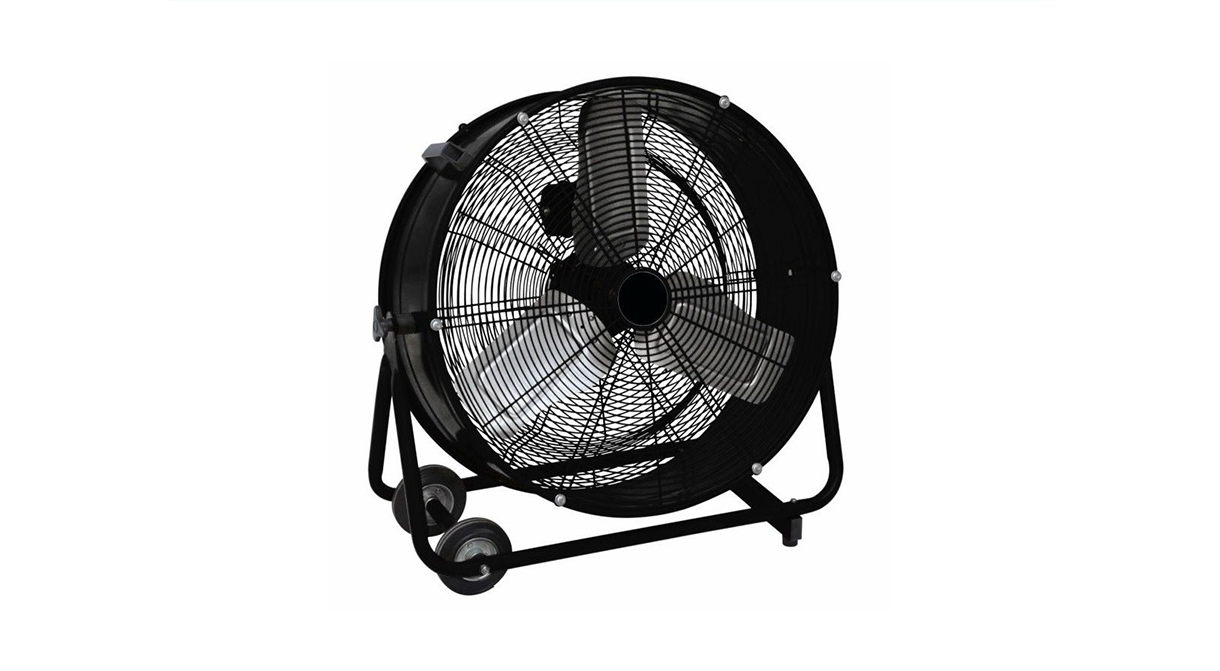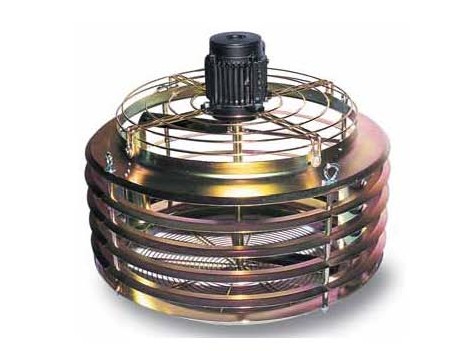Drum Fans - Background
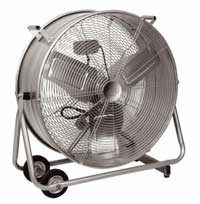
Mobile Drum fan
Used for a variety of cooling and air movement applications, drum fans have for a long time been popular assets for companies and organisations. Used for cooling staff in factories, livestock in sheds, or creating a breeze in a photographic studio, drum fans prove themselves time again as very versatile machines. Looking at the market there are actually quite a variety of sizes and features that have significant effects on an individual fans usability. Before making an investment in a drum fan it is worth considering the variations and features in the different products. Sometimes called man coolers, or floor fans, barrel fans and sometimes known as cooler fans, these drum fans are indeed far more useful than that name suggests.
Man Coolers - Airflow, air velocity and air throw
Often advertised as 'massive' 30" Ø drum fan or 36" Ø drum fan, it must be remembered that size does not always mean large airflow. It is possible to get a 24" drum fan with a larger air flow than a 30" Ø. Air flow matters because the air velocity from a fan, which is almost never mentioned in the specifications, is of course a factor of the air flow and the drum fans physical size. It stands to reason therefore that a 30" drum fan with an air flow of say 14000m3/hr will generate a lower air velocity than a 24" Ø fan that moves the same air volume.
The air throw is a term that is derived from the air velocity and is taken to mean the furthest distance from fan (or other discharge point) where an air velocity of 0.5m/s can be measured. Although very complex to calculate and time-consuming to set up and measure, the general truth is that the greater the velocity from the fan, the greater the air throw.
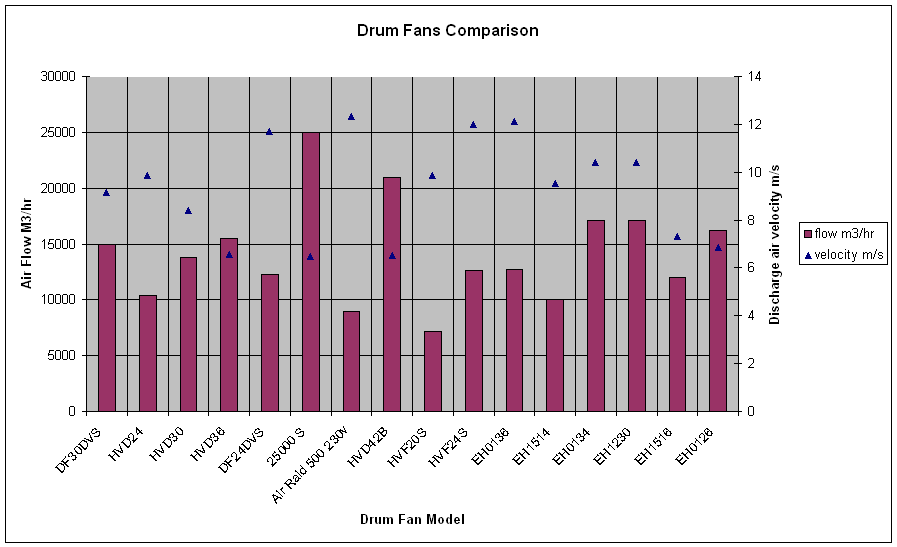
Drum Fans - comparison of air flow and discharge velocity
Generally for cooling applications more airflow and less velocity is good because means that light things like paper don't go flying, but on the other hand if cooling in a large area like a warehouse is required perhaps air throw is more important in order to get effective air movement further from the fan. With drum fans that have higher discharge velocities it is worth selecting ones that have more than one speed setting, so that you have the capability to choose a lower velocity if required.
Drum Fans - Electricity Supply
Drum fans are usually quite low power machines and equipped to run from a single phase 230v supply. Some models have the added flexibility of being able to operate from either 230v or 110v, i.e. they are what is referred to as 'duel voltage'.
Fan Mounting on Drum Fans
There is quite a variation in the mounting arrangements that actually support the fan of the actual drum fan. The following table explains some of the variants;
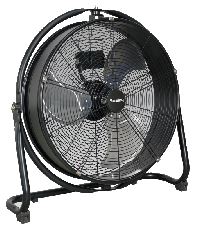 Drum Fan - Orbital type | A simple stand with no wheels is the simplest support, although with a stand you should at least expect a swivel mounting to enable the drum fan to be pivoted to point any angle vertical up, through horizontal to vertical down. The drum fan in this picture has an orbital which means it can be pivoted to point in any direction without moving the stand. |
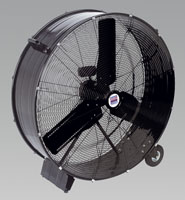 Simple Mobile Drum Fan | When the drum fan casing is fitted with simple wheels and stand without any pivot, the result is a drum fan that is actually very limited and can only discharge on a horizontal plane and to which has to be moved to blow at a different angle. |
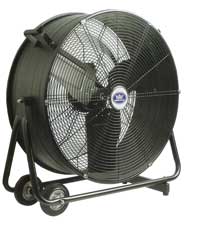 Mobile Pivoting Drum Fan | With a wheel mounting frame the drum fan becomes much more flexible particularly if it is pivot mounted so that air can be discharged at any angle through its vertical plane. |
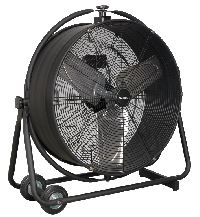 Mobile orbital drum fan | The ultimate in drum fan flexibility comes when the fan is mounted on a wheeled frame and set in an orbital pivot arrangement. This means that the fan can be pointed in any direction without moving the wheeled frame . |
Drum Fan - Variable output and speeds
- The more speed settings on a drum fan the better. Some are fixed speed fan i.e. on or off, which is of little use. Most of the drum fans we supply are 2 or 3 speed.
- 2 speeds - good
- 3 speeds - better
- variable speed - best !
Hi-bred fans
Some fans are part drum fans and part ventilation fans. That is to say they look like a drum fan but have sufficient pressure capability that they can be used to move air along a limited length of ducting. Notable models with this capacity are;
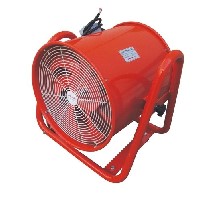
Broughton VF600 drum fan/ ventilation fan hi-bred
Broughton VF600.The Broughton VF600 is a notable fan because it is so versatile and does not fall cleanly into any category. As a drum fan it has the highest discharge velocity of the range, it has casters, two of which are braked which is useful, and it has a lockable pivot within its frame. With such a high discharge velocity (nearly 14m/s) it will have more air throw reach for cooling in industrial applications, and would be ideal in photographic studios where a localised but strong wind is required. But with a much higher pressure capability than a normal drum fan, this unit can also be used as a large ventilation fan and can easily push or pull air along a 10m duct. Even when compared with other ventilation fans it is a bit of an oddity as it is larger than other axial type ventilation fans on our range; the next smaller one moves about half the air volume as the VF600 ! To cap it all it is even available as a 230V or as 110v version.
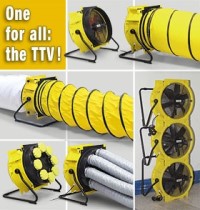
TTV fan accessories
Trotec TTV series. The Trotec TTV series fans can be used both as a drum fans or man coolers, or with ducting on, as a ventilator fans. But more than that you can stack them to make a small wind wall, or put on a numerous smaller ducts to deliver air to different spaces.
An often overlooked feature on some ventilation fans is an open base, such as the TTV fans are fitted to. The benefit of this type of frame is that you can connect duct and have it hanging down through a hatch or manhole into a confined space. Conclusions Basic drum fans are not expensive to buy; at the entry end of the market there are numerous options available which are perfectly capable fans. If however your requirements are less straightforward and you require larger air flows, or more versatility, like duel voltage and orbital then there are plenty options Our advice for choosing a suitable drum fan or man cooler is to consider;
- Your requirement carefully, not just your immediate application for the fan but also potential future requirements
- Size of the area in which the fan is to be used
- Do you need fixed discharge direction, pivoting or orbital type
- Voltage; 230v or 110v
If you need any help to choose a drum fan or accessories, give us a call on 0845 6880112

